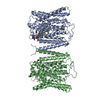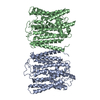+ データを開く
データを開く
- 基本情報
基本情報
| 登録情報 |  | |||||||||||||||
|---|---|---|---|---|---|---|---|---|---|---|---|---|---|---|---|---|
| タイトル | Cryo EM structure of human phosphate channel XPR1 at intermediate state | |||||||||||||||
 マップデータ マップデータ | ||||||||||||||||
 試料 試料 |
| |||||||||||||||
 キーワード キーワード | phosphate channel / membrane protein / phosphate homeostasis / TRANSPORT PROTEIN | |||||||||||||||
| 機能・相同性 |  機能・相同性情報 機能・相同性情報phosphate transmembrane transporter activity / phosphate ion transport / intracellular phosphate ion homeostasis / phosphate ion transmembrane transport / cellular response to phosphate starvation / inositol hexakisphosphate binding / efflux transmembrane transporter activity / response to virus / virus receptor activity / plasma membrane 類似検索 - 分子機能 | |||||||||||||||
| 生物種 |  Homo sapiens (ヒト) Homo sapiens (ヒト) | |||||||||||||||
| 手法 | 単粒子再構成法 / クライオ電子顕微鏡法 / 解像度: 4.59 Å | |||||||||||||||
 データ登録者 データ登録者 | Lu Y / Yue C / Zhang L / Yao D / Yu Y / Cao Y | |||||||||||||||
| 資金援助 |  中国, 4件 中国, 4件
| |||||||||||||||
 引用 引用 |  ジャーナル: Science / 年: 2024 ジャーナル: Science / 年: 2024タイトル: Structural basis for inositol pyrophosphate gating of the phosphate channel XPR1. 著者: Yi Lu / Chen-Xi Yue / Li Zhang / Deqiang Yao / Ying Xia / Qing Zhang / Xinchen Zhang / Shaobai Li / Yafeng Shen / Mi Cao / Chang-Run Guo / An Qin / Jie Zhao / Lu Zhou / Ye Yu / Yu Cao /   要旨: Precise regulation of intracellular phosphate (Pi) is critical for cellular function, with xenotropic and polytropic retrovirus receptor 1 (XPR1) serving as the sole Pi exporter in humans. The ...Precise regulation of intracellular phosphate (Pi) is critical for cellular function, with xenotropic and polytropic retrovirus receptor 1 (XPR1) serving as the sole Pi exporter in humans. The mechanism of Pi efflux, activated by inositol pyrophosphates (PP-IPs), has remained unclear. This study presents cryo-electron microscopy structures of XPR1 in multiple conformations, revealing a transmembrane pathway for Pi export and a dual-binding activation pattern for PP-IPs. A canonical binding site is located at the dimeric interface of Syg1/Pho81/XPR1 (SPX) domains, and a second site, biased toward PP-IPs, is found between the transmembrane and SPX domains. By integrating structural studies with electrophysiological analyses, we characterized XPR1 as an inositol phosphates (IPs)/PP-IPs-activated phosphate channel. The interplay among its transmembrane domains, SPX domains, and IPs/PP-IPs orchestrates the conformational transition between its closed and open states. | |||||||||||||||
| 履歴 |
|
- 構造の表示
構造の表示
| 添付画像 |
|---|
- ダウンロードとリンク
ダウンロードとリンク
-EMDBアーカイブ
| マップデータ |  emd_39230.map.gz emd_39230.map.gz | 117.9 MB |  EMDBマップデータ形式 EMDBマップデータ形式 | |
|---|---|---|---|---|
| ヘッダ (付随情報) |  emd-39230-v30.xml emd-39230-v30.xml emd-39230.xml emd-39230.xml | 15.1 KB 15.1 KB | 表示 表示 |  EMDBヘッダ EMDBヘッダ |
| FSC (解像度算出) |  emd_39230_fsc.xml emd_39230_fsc.xml | 10.6 KB | 表示 |  FSCデータファイル FSCデータファイル |
| 画像 |  emd_39230.png emd_39230.png | 82.7 KB | ||
| Filedesc metadata |  emd-39230.cif.gz emd-39230.cif.gz | 5.7 KB | ||
| その他 |  emd_39230_half_map_1.map.gz emd_39230_half_map_1.map.gz emd_39230_half_map_2.map.gz emd_39230_half_map_2.map.gz | 116.1 MB 116.1 MB | ||
| アーカイブディレクトリ |  http://ftp.pdbj.org/pub/emdb/structures/EMD-39230 http://ftp.pdbj.org/pub/emdb/structures/EMD-39230 ftp://ftp.pdbj.org/pub/emdb/structures/EMD-39230 ftp://ftp.pdbj.org/pub/emdb/structures/EMD-39230 | HTTPS FTP |
-検証レポート
| 文書・要旨 |  emd_39230_validation.pdf.gz emd_39230_validation.pdf.gz | 820.5 KB | 表示 |  EMDB検証レポート EMDB検証レポート |
|---|---|---|---|---|
| 文書・詳細版 |  emd_39230_full_validation.pdf.gz emd_39230_full_validation.pdf.gz | 820 KB | 表示 | |
| XML形式データ |  emd_39230_validation.xml.gz emd_39230_validation.xml.gz | 19 KB | 表示 | |
| CIF形式データ |  emd_39230_validation.cif.gz emd_39230_validation.cif.gz | 24.7 KB | 表示 | |
| アーカイブディレクトリ |  https://ftp.pdbj.org/pub/emdb/validation_reports/EMD-39230 https://ftp.pdbj.org/pub/emdb/validation_reports/EMD-39230 ftp://ftp.pdbj.org/pub/emdb/validation_reports/EMD-39230 ftp://ftp.pdbj.org/pub/emdb/validation_reports/EMD-39230 | HTTPS FTP |
-関連構造データ
| 関連構造データ |  8yfuMC  8yetC  8yexC  8yf4C  8yfdC  8yfwC  8yfxC  9iwsC M: このマップから作成された原子モデル C: 同じ文献を引用 ( |
|---|---|
| 類似構造データ | 類似検索 - 機能・相同性  F&H 検索 F&H 検索 |
- リンク
リンク
| EMDBのページ |  EMDB (EBI/PDBe) / EMDB (EBI/PDBe) /  EMDataResource EMDataResource |
|---|
- マップ
マップ
| ファイル |  ダウンロード / ファイル: emd_39230.map.gz / 形式: CCP4 / 大きさ: 125 MB / タイプ: IMAGE STORED AS FLOATING POINT NUMBER (4 BYTES) ダウンロード / ファイル: emd_39230.map.gz / 形式: CCP4 / 大きさ: 125 MB / タイプ: IMAGE STORED AS FLOATING POINT NUMBER (4 BYTES) | ||||||||||||||||||||||||||||||||||||
|---|---|---|---|---|---|---|---|---|---|---|---|---|---|---|---|---|---|---|---|---|---|---|---|---|---|---|---|---|---|---|---|---|---|---|---|---|---|
| 投影像・断面図 | 画像のコントロール
画像は Spider により作成 | ||||||||||||||||||||||||||||||||||||
| ボクセルのサイズ | X=Y=Z: 1.1 Å | ||||||||||||||||||||||||||||||||||||
| 密度 |
| ||||||||||||||||||||||||||||||||||||
| 対称性 | 空間群: 1 | ||||||||||||||||||||||||||||||||||||
| 詳細 | EMDB XML:
|
-添付データ
-ハーフマップ: #1
| ファイル | emd_39230_half_map_1.map | ||||||||||||
|---|---|---|---|---|---|---|---|---|---|---|---|---|---|
| 投影像・断面図 |
| ||||||||||||
| 密度ヒストグラム |
-ハーフマップ: #2
| ファイル | emd_39230_half_map_2.map | ||||||||||||
|---|---|---|---|---|---|---|---|---|---|---|---|---|---|
| 投影像・断面図 |
| ||||||||||||
| 密度ヒストグラム |
- 試料の構成要素
試料の構成要素
-全体 : Cryo EM structure of human phosphate channel XPR1 at intermediate...
| 全体 | 名称: Cryo EM structure of human phosphate channel XPR1 at intermediate state |
|---|---|
| 要素 |
|
-超分子 #1: Cryo EM structure of human phosphate channel XPR1 at intermediate...
| 超分子 | 名称: Cryo EM structure of human phosphate channel XPR1 at intermediate state タイプ: complex / ID: 1 / 親要素: 0 / 含まれる分子: all |
|---|---|
| 由来(天然) | 生物種:  Homo sapiens (ヒト) Homo sapiens (ヒト) |
-分子 #1: Solute carrier family 53 member 1
| 分子 | 名称: Solute carrier family 53 member 1 / タイプ: protein_or_peptide / ID: 1 / コピー数: 2 / 光学異性体: LEVO |
|---|---|
| 由来(天然) | 生物種:  Homo sapiens (ヒト) Homo sapiens (ヒト) |
| 分子量 | 理論値: 70.388328 KDa |
| 組換発現 | 生物種:  Homo sapiens (ヒト) Homo sapiens (ヒト) |
| 配列 | 文字列: QYEAFKDMLY SAQDQAPSVE VTDEDTVKRY FAKFEEKFFQ TCEKELAKIN TFYSEKLAEA QRRFATLQNE LQSSLDAQKE STGVTTLRQ RRKPVFHLSH EERVQHRNIK DLKLAFSEFY LSLILLQNYQ NLNFTGFRKI LKKHDKILET SRGADWRVAH V EVAPFYTC ...文字列: QYEAFKDMLY SAQDQAPSVE VTDEDTVKRY FAKFEEKFFQ TCEKELAKIN TFYSEKLAEA QRRFATLQNE LQSSLDAQKE STGVTTLRQ RRKPVFHLSH EERVQHRNIK DLKLAFSEFY LSLILLQNYQ NLNFTGFRKI LKKHDKILET SRGADWRVAH V EVAPFYTC KKINQLISET EAVVTNELED GDRQKAMKRL RVPPLGAAQP APAWTTFRVG LFCGIFIVLN ITLVLAAVFK LE TDRSIWP LIRIYRGGFL LIEFLFLLGI NTYGWRQAGV NHVLIFELNP RSNLSHQHLF EIAGFLGILW CLSLLACFFA PIS VIPTYV YPLALYGFMV FFLINPTKTF YYKSRFWLLK LLFRVFTAPF HKVGFADFWL ADQLNSLSVI LMDLEYMICF YSLE LKWDE SKGLLPNNSE ESGICHKYTY GVRAIVQCIP AWLRFIQCLR RYRDTKRAFP HLVNAGKYST TFFMVTFAAL YSTHK ERGH SDTMVFFYLW IVFYIISSCY TLIWDLKMDW GLFDKNAGEN TFLREEIVYP QKAYYYCAII EDVILRFAWT IQISIT STT LLPHSGDIIA TVFAPLEVFR RFVWNFFRLE NEHLNNC UniProtKB: Solute carrier family 53 member 1 |
-実験情報
-構造解析
| 手法 | クライオ電子顕微鏡法 |
|---|---|
 解析 解析 | 単粒子再構成法 |
| 試料の集合状態 | particle |
- 試料調製
試料調製
| 緩衝液 | pH: 7.5 |
|---|---|
| 凍結 | 凍結剤: ETHANE |
- 電子顕微鏡法
電子顕微鏡法
| 顕微鏡 | FEI TITAN KRIOS |
|---|---|
| 撮影 | フィルム・検出器のモデル: GATAN K3 (6k x 4k) / 平均電子線量: 50.0 e/Å2 |
| 電子線 | 加速電圧: 300 kV / 電子線源:  FIELD EMISSION GUN FIELD EMISSION GUN |
| 電子光学系 | 照射モード: SPOT SCAN / 撮影モード: BRIGHT FIELD / 最大 デフォーカス(公称値): 2.6 µm / 最小 デフォーカス(公称値): 1.0 µm |
| 実験機器 |  モデル: Titan Krios / 画像提供: FEI Company |
 ムービー
ムービー コントローラー
コントローラー











 Z (Sec.)
Z (Sec.) Y (Row.)
Y (Row.) X (Col.)
X (Col.)





































